#The rest of this file is sketches and anime tropes
Text

Not done with the page or fic, but here’s a lil peek
#Laishuro#laios touden#shuro#toshiro nakamoto#dungeon meshi#The rest of this file is sketches and anime tropes#I will not elaborate on which 🤭#But! I want the fic to be center around Toshiro having Laios help him with food issues and instability in the East#soooo lots of food involved!#It’s a good thing I’m a foodie and a fan of the book ‘The science of cooking’ this YAOI is my calling#Sam’s doodles of the day
671 notes
·
View notes
Text
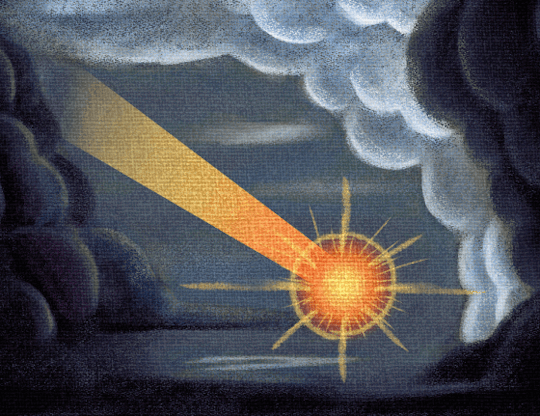
animated GIF 19/01/2023
Today I made this animated gif in Clip Studio Paint. It's a very simple three-frame animation that give an effect similar to "line boil", which according to TV Tropes is "the wobble of hand-drawn lines, particularly noticeable when characters are redrawn in every frame even though they are standing still."
This animation was made largely as a test, sort of an animated sketch to get a feel for how I might like to do things for my proper animation.
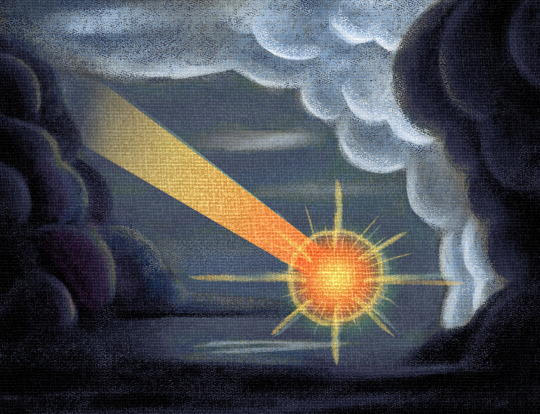
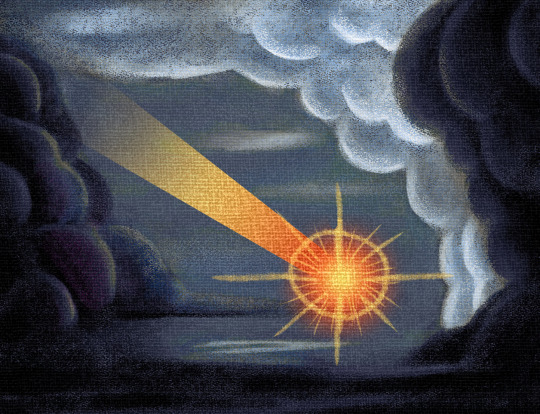
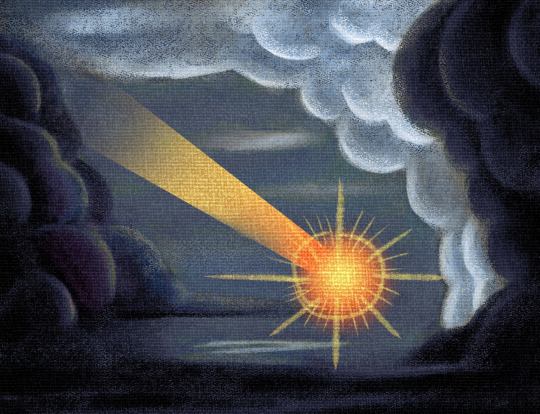
These are my three frame (the background it included in the exported image file, but the cells only held the comet). I initially wanted the comet to be more ornate and painterly, like my reference, but I was finding it difficult to make that look good without wanting to spend a lot of time on it (that's on me; you can have ornate or you can have quick, you can't have both). So I decided to make it more graphic with defined side on the tail and using gradients instead of applying colour manually. I think it looks nice! But I'll definitely have to do more style research.
The background I painted digitally, primarily using the gouache brush and using minimal layers to make use of the brush's blending effects. I decided fairly early on to work on this in black and white and apply colour through gradient masks and clipping layers afterwards, which let me focus on value without worrying about colours. Underpainting!
I also applied a canvas texture preset to the entire animation, since I felt it added a little more visual interest. The original reference doesn't actually have much texture, but I took plenty of creative license.
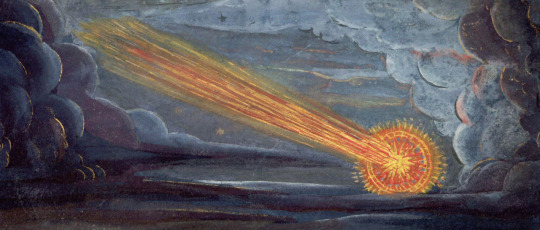
This is the illustration I used as reference, from The Comet Book (1587).
This is my process video. Creating this took about two hours, with roughly 50 minutes on the background and the rest on the comet and finessing the animation.
13 notes
·
View notes
Note
For the writer asks - imma be cruel and have you answer all the odd numbers!!
Why you gotta be so cruel curl!!?
1. Tell us about your current project(s) – what’s it about, how’s progress, what do you love most about it?
I am currently trying to finish up some of my porn draft collections that have been left in my files, but I can’t write porn to save a life. I am currently too busy trying to settle my ever-building assignments before the deadline, and my parent’s ever-watching eyes, so I do not have the time to settle some sketches or any stories unless I decided to rage quit and just do it or I am in that horny writer mode (which ironically happens at very late nights.)
Those WIPs are what I considered as my pride and joy because they are what I considered as a stepping stone to be an adult-content writer.
3. What is that one scene that you’ve always wanted to write but can’t be arsed to write all of the set-up and context it would need? (consider this permission to write it and/or share it anyway)
The answer is at question 13.
5. What character you’re writing do you most identify with?
When I write each character, I try to put myself in their place and think about what would they say based on their personality. I try not to make it too OC with them.
It might sound biased, but I feel more connected when I write as Rook. With him, I can easily think of the expressions he might make and the words he would say and through that, I can plan out the rest of the scenes and what happens next.
7. What do you think are the characteristics of your personal writing style? Would others agree?
Funny, sweet, romantic and all of the good feels. Everyone needs some good feels and the fluffy softness in their life.
9. Are you more of a drabble or a longfic kind of writer? Pantser or plotter? Do you wish you were the other?
Wish I could drabble, but I always found myself writing a longfic. My drabbles are usually in the form of pointer notes because it’s faster to write it all out and easily be read again and again.
I usually write based on how it feels and how brings the readers along the ride. I want the words every character has said to feel the raw emotions that actually stir the heart, but for those scenarios I find myself ending up in the drafts collecting dust. So I guess that makes me a plotter writer with a pantser mind.
11. What do you envy in other writers?
The ability to build up the drama throughout the story until the final bombastic drop. I am still learning, I admit that, but at the same time I always feel myself being such a cliche writer.
13. Do you share your writing online? (Drop a link!) Do you have projects you’ve kept just for yourself?
Yes in AO3 and Tumblr.
Yes. There are some ABO drabbles in this fandom that I know not many people would read it, so I just keep it to myself. If you are fine with it and are still curious, do message me so that Iknow that I got your consent to publish it.
15. Which is harder: titles or summaries (or tags)?
Porn. In details.
17. Do you think readers perceive your work - or you - differently to you? What do you think would surprise your readers about your writing or your motivations?
I don’t know how to answer that actually.
19. Is there something you always find yourself repeating in your writing? (favourite verb, something you describe ‘too often’, trope you can’t get enough of?)
As, only to reveal, and there stood...and many more that I have forgotten. Much to my English Language Nazi cringiness.
21. What other medium do you think your story would work well as? (film, webcomic, animated series?)
A series, because that’s how my brain works when I write them.
23. What’s the story idea you’ve had in your head for the longest?
Kiler!Doc au, Demon/Angel au, and some other stuff. (hint: ALL of them are involved with my porn WIPs)
25. What part of writing is the most fun?
The funny scenes, they play in my mind like a film.
1 note
·
View note
Text
Screw It, I’m Making a Webcomic
So, as I made it abundantly clear on Twitter mere moments ago, I have a real honest-to-Glob New Year’s Resolution for 2017.
I am going to create a webcomic.
I am going to write a sequential art narrative which I will draw and provide various artistic accoutrements to and post it on the Internet. This is going to happen by the end of this year. I am doing this.
Perhaps this sudden outburst and declaration of artistic intent seems a bit out of left field, both in its overtones of grandiosity and relative lack of context given what most of you guys know about me. So let me provide some of that much needed context, both to show you why I am doing this and what I am really saying, which is probably even more ambitious (and maybe pretentious) than you think it is.
I’ve been writing weird little stories and drawing accompanying illustrations for them since I was a wean, as most of us did at that age, but since that point I’ve never really stopped. At a very young age I encountered not only excellent children’s books ranging from the charming and heartwarming to the downright mind-bending—Peter Sís and Henrik Drescher were big in my household—but also illustrated works whose contents and subtext were far too old for me yet entranced me nonetheless, particularly the works of the great New England illustrator and satirist Edward Gorey. By the age of six or seven, I had memorised “The Gashlycrumb Tinies” and would recite it with morbid glee to anyone who would ask (or didn’t). I discovered books through Gorey’s cover illustrations, first accidentally discovering the alternate history genre through his work on Joan Aiken’s Dido Twite series, and was only drawn deeper into John Bellairs’ junior Gothics when I discovered that Gorey had provided the frontispiece and dust jacket to every one of the entries in the series he’d written up to his death—which I mourned, with a mix of vague incomprehension, sorrow, and creeping disappointment. I was eight at the time.
Parallel to this, I spent a lot of time at my town’s local art centre, which provided free classes in all sorts of artistic endeavours. I took most to theatre and improv in particular—I was a wee ham; now I am a large ham—but what stuck with me was drawing and, to a lesser extent, animation. As I fixated on Gorey’s superficial techniques and aesthetics, the simple sunken eyes and odd little triangular noses, I’d also more subtly acquired his less obvious techniques: The way he used cross-hatching and simple, intense linework to suggest different textures entranced me, and indeed still does. I am told that a very strict art teacher, who I thought disliked me and of whom I was somewhat afraid, freely admitted that a sketch I’d done of a horned figure playing a flute on a rooftop by the light of the moon had taken her breath away.
Which is not to say that I was, or am, some prodigy of form, or that I lacked for more prosaic influences. The former, I will get to, but the latter is best expressed in the fact that a recurring scene which I have since revised and transfigured many, many times began life as... well, thinly veiled Darkwing Duck fanfiction, minus the duck part, given a sound twist of Lovecraft’s “The Statement of Randolph Carter”. I was maybe eleven or so at the time.
It was in one of these classes that this weird little scene deep beneath a ruined graveyard was born. It was also there that I made plans for an elaborate series of beast fables, set in a world quite unlike our own.
It is perhaps worth noting that one of the handful of these early sketches which sticks in y mind to this day was a tale of two young male lizards falling in love only to be torn apart by a disapproving society. Even at an age when I was functionally unaware of homosexuality and bemused or outright repulsed by what I knew of sex, a queer romance was perhaps the most emotionally intense thing that I had conceived of up to that point. But I digress.
The setting in question and certain characters in it would perennially re-emerge in my other writing, which I was quite certain would be my career path throughout late elementary and middle school. In seventh grade, I was part of an experimental programme where middle and high school students were allowed to enrol in a creative writing course at a nearby university. Only two students wound up attending: Myself, and a classmate of mine who had skipped a grade and would later become known in my high school as something of a mad and insufferable genius. (We got on pretty well.) After several semesters of studying poetry and short fiction, there was a presentation. One of the selections I made for my reading was a list-poem, from the perspective of an older character trying to live day by day with the memory of his deceased wife hanging over him, with the distinction that the final entry was a reminder to keep his claws neatly filed.
It was around that time that I began to come under the influence of Thomas Ligotti, and it was with this exposure to the refiner’s fire of such elegant horror—the kind that brought the same sort of visions into my mind that Gorey brought to the page—that I realised what form my true opus should take, at least in plot. I took it with me into high school, and beyond into the wilderness of these past six-and-a-half years of confusion. The polestar of this mad endeavour formed here.
I had been thinking a lot about epic high fantasy at the time—I was eleven when The Return of the King hit theatres, and I had read enough in the genre and in styles adjacent to it to be aware of the tropes—and it occurred to me that the moral framework and cosmology of a lot of such works rang a bit hollow to me, not because right and wrong did not exist, as certainly people do good and bad things to one another all the time, but because there was always this sense of certainty that the side one was meant to root for was indubitably in the right and some great objective force of Good deemed it so, blessing their struggle against a force similarly ordained by some great objective Evil. It was that last dimension which particularly irked me. It felt reassuring in the most painfully reductive and philosophically trite way possible. And so often the battles were so... literal. I never much cared for war films to begin with, and by putting such struggles in a fantastical framework, you subtracted the one thing that made war films kind of neat: The recognition that these were people doing the fighting and the killing. Not symbols, people.
Very middle school analysis, yes, and unfair to some things I quite enjoy, Tolkien included, but the ultimate conclusions were the important part.
Which is where Ligotti comes in. Much has been made of his non-fiction opus The Conspiracy Against the Human Race, but in terms of his philosophy and its influence on my thinking at the time, I’d rather stick to his fiction, as that was what I was reading and that is what made me. In brief, Ligotti is not a reassuring writer. The universe of his stories reflects his views of our own, which are, in essence, a wholesale rejection of the commonly held notion that human consciousness and life in general are good things that we should all be even remotely enthused about, instead proposing that the very idea that we are aware of ourselves and that we should think of ourselves as individuals for whom some higher power might just be watching out is more likely an obscene and sadistic joke on that hypothetical power’s part or else, more likely, a horrible accident. His stories are filled with personal totems and surreal motifs, the fates of his characters determined by blind chance or the detached malicious prankstery of a party with whom they cannot bargain or reason, the sadistic frenzies of Poe’s maniacal villain-protagonists writ large, often on a cosmic scale. There is the feel of a nightmare and yet also of the sleepless hours after, alone in the dark, thinking, where wakefulness and dream bleed between one another and all the world is a nightmare to which the hells of sleep might well be preferable.
If I’ve lost you, well, I’m sorry; but you and I probably have something to talk about if your first reaction to all this was, “I’ve certainly had *those* days.”
And if you’ve had enough of those days, the rest probably follows easily enough.
Wouldn’t it be interesting, I thought, if one took that quest narrative key to so many epic fantasies, and put it through a world where the rules of the game were so utterly reversed? If our well-meaning hero—of course, as in Tolkien, basically some poor backwater schmo, by no means stupid nor necessarily naïve but very, *very* far from the classical man of virtue—were to bear with him some artefact of power that could, perhaps by its very existence, rend the veil of normalcy that should keep all of the sane and happy citizens of this world from confronting what writhes beneath all that they see, what might he choose to do with it, particularly if he were, say, by some inexplicable invisible bond, *tied* to it?
Now, what makes a fitting antagonist for such a tale? What sort of character provides the ideal foil for a kind-hearted soul confronted with all the horrors of what may be in a neat little package? Rather than some cosmic sadist intent on throwing us all under the bus, why not something a bit scarier: Another kind-hearted soul. Someone who has seen behind the veil their whole life. Someone who has seen the truth and the agony of this world and seeks nothing less than perfect closure
And there it was.
And then it began to get complicated.
For every character that I created to flesh out the story, another came into being, and I wanted to know more about them. A side-plot salvaged from some other silly project merged seamlessly into the new whole, and suddenly there were whole new plots, full of new characters with motives that I wanted to understand. Characters grew, changed, lightened and darkened as my thoughts steeped. Exposure to other writers through classes and forums and variably disastrous shared writing projects made me realise what I did and did not know, what I could and could not do.
It was also in high school that I began taking music seriously, first toying around in Garageband and singing in the school choir and then as part of a band with several close friends. I wrote a lot of poetry, and I sang a bit, so we had lyrics; I still drew sometimes, so we had art when we needed it, although we rarely needed it. I was always ambitious with my lyrics: One of our most successful songs was structured to simulate one character murdering another during a snowstorm in a glade where they had played and hidden as a child. Morbid character studies were common; I was always taking grim little vacations in people’s heads, my own or otherwise. Informed by my middle school studies of haibun and my lyrical adventures, my prose grew more experimental, collapsing into poems or switching into strange persons and tenses. My mind was full of images, yet where to go with them?
My path to sequential art was an odd and rocky one. As mentioned, I loved picture books and illustrated stories as a child, and while I failed to touch upon them earlier (mea culpa!), Calvin and Hobbes and The Far Side were pretty important in their own right. I even attempted to create something of a running series at around the time I was in that poetry programme, mainly for the amusement of myself and a very affable art teacher who found the premise amusing. It was only a year or two later that I would read Doom Patrol—the first superhero comic that I would ever admit to liking, and still one of the chosen few—and realise that Grant Morrison, the bastard, had stolen my idea before I’d even been born: Of killing one’s own imaginary friend, only to be tormented by their vengeful spectre years after the fact at the least appropriate of times.
But the comic idea sort of fell by the wayside for the longest time, for the simple reason that I am, to my own mind, an atrocious draughtsman. I cannot reproduce figures to save my life. Hilarious, seeing as I can draw you a teeming alien cityscape, or a perfectly detailed mosquito in flames, but in terms of doing the same thing twice, I’ve spent years hanging my head in shame and self-loathing.
The secret is, though, not that I couldn’t learn this, but that for such a long time, pride had kept me from allowing myself to be bad at things until I was good. As someone to whom a lot of fairly complex ideas just come naturally, someone who just absorbs information like a souped-up Dyson vacuum, the idea of having to draw the same damned thing ten thousand times just to get decent at drawing that same damned thing was a horrifying prospect. It still is.
I got pushed into it. My own fictions put a knife to my throat and told me, “This is what needs to happen.” But it took two different interconnected experiences to understand how, both courtesy of my boyfriend being a huge dork.
The first was his recommendation that I read LAMEZINE 02, at that time the latest salvo from the wonderfully deranged comic artist Cate Wurtz, then going by the moniker Partydog; the second was his use of a Bec Noir avatar on a forum we’re both on, which got me to finally bite the bullet and read Homestuck.
Wurtz’ Lamezone comics are a trip. Her art style is by most technical standards fairly primitive, but it’s a very *refined* jankiness, part and parcel to her overall embrace of scuzzy punk ‘zine aesthetics, immediately recognisable and all-around immediate. Her approach to story and tone is just the same, at once surreal and ridiculous and incredibly emotionally potent, ranging in tone from giddy B-movie absurdity to crushing Carver-esque sorrow, composed of as many little side-stories that flesh out what sort of world these characters live in as of its “meat” and all the better for it. The way that her comics are often framed only adds to the ambience: DVD menus of hit TV series that never existed, tales from the everyday lives of people living on the precipice of madness (and/or suburban Kansas), the wild Lynchian adventures of a man who talks to the spirit of the good ol’ USA through Twitter while traipsing through other people’s comics and the comment sections on furry porn sites. She was even working on a video game at one point about a woman trying to battle her way through deformed iterations of her past selves while maintaining a sufficient ganja supply. I have no idea if that’s still happening. It looked awesome.
Homestuck has already had much said about it, so I’ll keep it brief. Comparisons to Pynchon are not unwarranted. It takes the hypertextual potential of the webcomic to the next level, and is longer than many novel series. The art is, quite intentionally, all over the place, and uses collage surprisingly effectively. The story is a beautiful mess that is, fundamentally, about the process of storytelling and how “things that happen” become “stories” in the first place. It’s very oblique about this, and generally quite funny.
And so I looked to the story I was writing.
I looked at the multiple plotlines growing out of one another, intersecting, snakes devouring their tails, thematic parallels on parallels, spirals of mental imagery with bits of torn wallpaper making the fabric of waistcoats and cathedrals made out of lines of scripture and trees bearing watches like fruit, and I went: “This should be a comic! A hypercomic, in fact, McLuhan-style! This should be a wondrous blend of visuals and text and...
“I...
“I can’t draw. Fuck me. I should stick to prose, like a good loser. Get rejected that way instead.”
So I waffled. For months. And then for years.
But you know what?
I’m done waffling.
Limitation is power in its own right. Ever since I learned of Oulipo in that long-ago three-person poetry class, I’ve been fascinated with the idea of innovation through defining what you cannot do, or what you must do, no matter what. Of forcing yourself to start from a set place or end at one, no ifs, ands or buts.
I am limited. Within that, I am omnipotent.
I am going to draw this comic. I am going to write it and I am going to draw it even if it starts out looking like total shit and the process drives me half-insane. If things that I love, in sequential art but also in music and painting and writing and animation and all sorts of other forms, can make a perceived deficit into a key strength, I can do it, too. Even if I can’t be a classical master, I can be the best at that crazy thing I do.
I guess this is also my grandiose way of saying “fuck last year,” where I made so much progress that felt so thwarted by external circumstances and my own failings, and where so much went wrong for so many of us. So I’m embracing this year as a year of progress. Even if everything else sucks, I’ll be running up that hill.
And just so there’s no mistaking it, I will still be making music and probably writing at least a smidgen of prose fiction and poetry on the side. In the former category, I might even start a band.
Oh, wait. We’re not doing half-measures any more.
I’m starting a band, too.
Tell your friends.
Happy 2017, everyone, and have a lovely rest of your night.
#Writings#my artwork#New Year's resolutions#important#rant#so many words my laird#DOING THE ART#comics#so many tags
6 notes
·
View notes